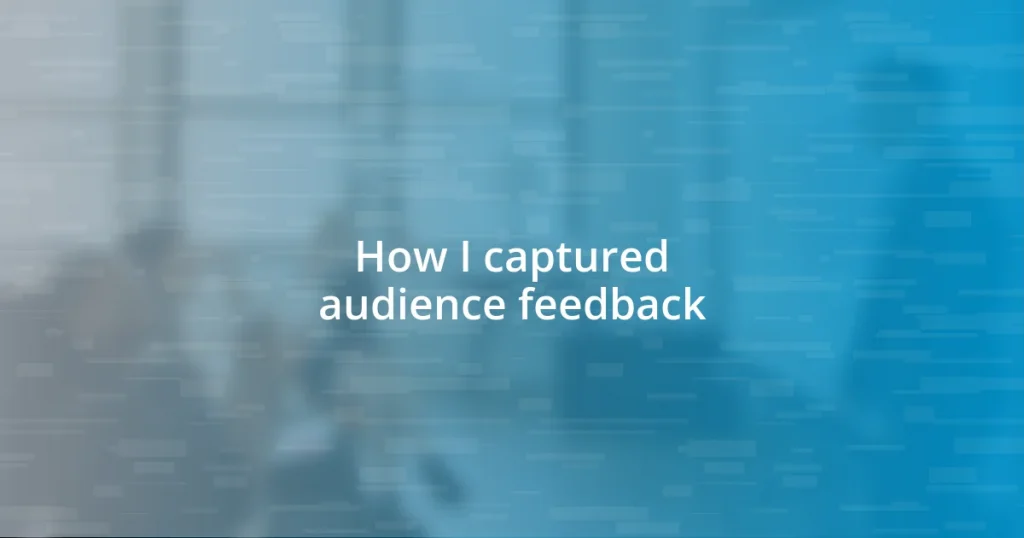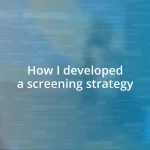Key takeaways:
- Audience feedback is essential for growth and understanding both the creator’s work and the audience’s needs.
- Choosing effective feedback tools and designing concise, engaging surveys directly impacts the quality of insights received.
- Analyzing feedback patterns and emotions enables creators to make informed changes, enhancing audience engagement and satisfaction.

Understanding audience feedback importance
Understanding audience feedback is crucial. It’s like holding up a mirror to your work, revealing insights that we often overlook ourselves. When I first started seeking feedback, I felt a mix of anxiety and excitement—what if they didn’t like what I created? But that fear quickly transformed into relief as I discovered how valuable those perspectives were to my growth.
I remember one specific moment when I presented a project I had poured my heart into. The audience’s feedback highlighted aspects I had never considered, such as clarity and engagement. It was enlightening! How often do we miss out on an opportunity to refine our ideas simply because we’re too close to them? Embracing what others share teaches us not just about our work but also about our audience’s needs and expectations.
Moreover, audience feedback fosters a sense of community and connection. When I engage with my audience and collect their insights, I don’t just improve my work; I create a dialogue. Can you think of a time when someone’s opinion shifted your perspective? Those moments remind us that feedback isn’t criticism; it’s a pathway to collaboration and shared growth.

Choosing the right feedback tools
Choosing the right feedback tools can be a game changer in how you capture audience insights. I remember when I first experimented with different platforms; it felt like trying on different shoes until I found the perfect fit. Some tools felt clunky and disconnected, while others created a seamless experience that made gathering feedback a breeze.
Here are some factors to consider when selecting your feedback tools:
- User Experience: The tool should be intuitive for both you and your audience.
- Data Analysis: Look for tools that help synthesize feedback easily.
- Customization: Can you tailor questions or formats to suit your specific needs?
- Engagement Features: Consider whether the tool offers ways to interact with your audience after collecting feedback.
- Integration: Ensure it connects well with other systems you use to streamline your process.
Finding the right combination made all the difference for me. Eventually, I settled on a platform that not only gathered responses but also encouraged a back-and-forth dialogue. That interaction has led to deeper insights and a stronger relationship with my audience.

Designing effective feedback surveys
Designing effective feedback surveys requires a thoughtful approach. From my experience, the questions you ask can significantly influence the quality of insights you receive. I once crafted a survey filled with open-ended questions, hoping for detailed responses, but the feedback was sparse. Transitioning to a mix of multiple-choice and scale ratings allowed my audience to articulate their thoughts more freely while providing me with quantifiable data to analyze. It’s like finding the right balance between structure and creativity!
Moreover, I’ve learned that keeping the survey concise is key. Early on, I made the mistake of asking too many questions, overwhelming my audience. It didn’t take long for me to realize that a shorter survey not only respects their time but also increases the chances of completion. Aiming for around 5 to 10 focused questions has worked wonders for me. Isn’t it fascinating how sometimes less truly is more?
Lastly, I’ve found that incorporating a personal touch, like sharing the purpose of the survey, makes a significant impact. When I included a brief note explaining why the feedback mattered to me, the response rate improved dramatically. It feels more like a conversation, doesn’t it? I genuinely believe that when participants understand the value of their feedback, they’re more likely to engage thoughtfully.
| Survey Design Element | Impact |
|---|---|
| Question Type | Shapes response quality and detail |
| Length of Survey | Affects completion rate and engagement |
| Personal Touch | Encourages thoughtful participation |

Analyzing feedback for actionable insights
Analyzing audience feedback goes beyond simply collecting data; it’s about uncovering the stories within the numbers. During one of my analysis sessions, I stumbled upon a trend showing that many participants felt overwhelmed by the information in my content. It hit me hard—I had been so focused on sharing everything I thought was valuable that I overlooked their need for clarity. This realization prompted me to streamline my messaging, which ultimately fostered a deeper connection with my audience.
Looking closely at feedback patterns can also reveal what resonates most. I remember going through comments and noticed consistent mentions of one particular theme that sparked excitement. It was a eureka moment for me! I decided to pivot my content strategy to explore this theme further. This shift not only delighted my audience but also enhanced my engagement metrics. Have you ever experienced a similar moment where feedback led you to an unexpected opportunity?
Another layer of analysis involves recognizing emotional triggers in responses. I found that when feedback included emotive language—words like “inspired” or “frustrated”—they were valuable cues for improvement. By prioritizing these responses and addressing the underlying sentiments, I was able to create more tailored content that truly spoke to my audience’s needs. Isn’t it interesting how emotions can guide the direction of our content creation? By tapping into these feelings, we can elevate our work from mere information delivery to a meaningful experience.

Implementing changes based on feedback
Adapting to audience feedback isn’t a one-time event; it’s an ongoing journey. I remember a workshop where participants voiced their desire for more interactive activities. Initially, I hesitated, preferring a lecture-style format. But the moment I integrated hands-on exercises, I saw an incredible shift. The energy in the room skyrocketed, and the feedback was overwhelmingly positive. It’s incredible how listening can transform a static environment into a vibrant, learning community.
After implementing changes based on feedback, I always keep an eye on how my audience reacts. For instance, when I started providing thumbnail visuals alongside my content, I wasn’t quite sure how it would resonate. To my surprise, engagement levels soared, and many participants expressed appreciation for the added clarity. It reminds me that small tweaks can lead to significant results. Have you felt that thrill when a simple change garners unexpected applause?
Ultimately, recognizing that feedback is a gift fosters a more open mindset. I’ve learned to see criticism not as a setback but as a stepping stone. When I faced pushback on my presentation style, instead of feeling defensive, I embraced the input. This mindset shift drove me to experiment with storytelling techniques. The result? An authentic connection with my audience that I’d never thought possible. Isn’t it fascinating how a shift in perspective can open doors to a richer interaction?

Measuring the impact of changes
When it comes to measuring the impact of changes, I’ve learned that it’s crucial to establish clear metrics beforehand. After revamping a workshop based on feedback, I set specific goals, such as increasing participation and satisfaction ratings. Those targets gave me a blueprint to evaluate how successful my adjustments really were, and seeing those numbers shift was both validating and motivating.
One time, after I introduced more visual elements to my presentations, I noticed a significant uptick in participant feedback scores. The joy on their faces was unmistakable—they were genuinely engaged, and the data reflected that excitement. It felt surreal to see a direct correlation between my changes and their reactions. Have you ever felt that rush when your efforts produce tangible results?
Additionally, I’ve found that gathering feedback post-implementation is just as important. I sent out a quick survey after a new interactive format, and the responses surprised me. The emotional words like “energized” and “connected” jumped off the page, reinforcing the idea that I was on the right track. How powerful is it to realize that adjustments based not only on what people say but how they feel can create a lasting impact? It’s a reminder that the numbers tell a story, but the emotions uncover the essence of our audience’s experience.
















